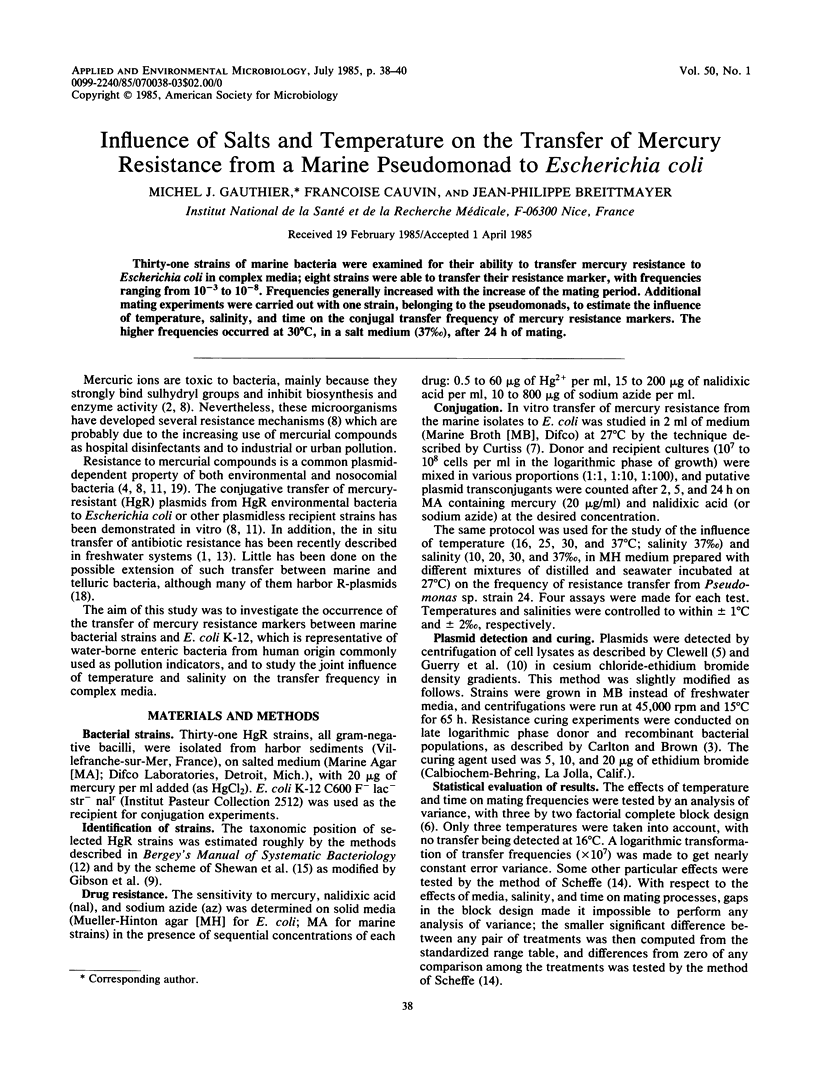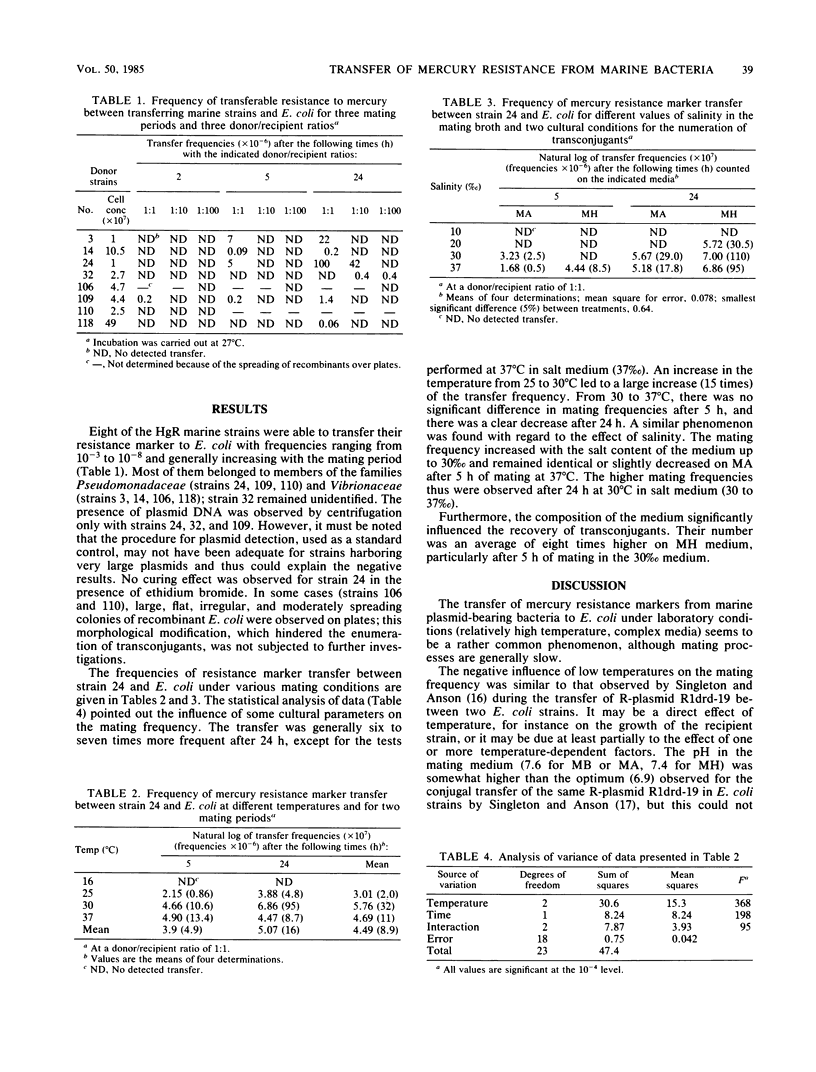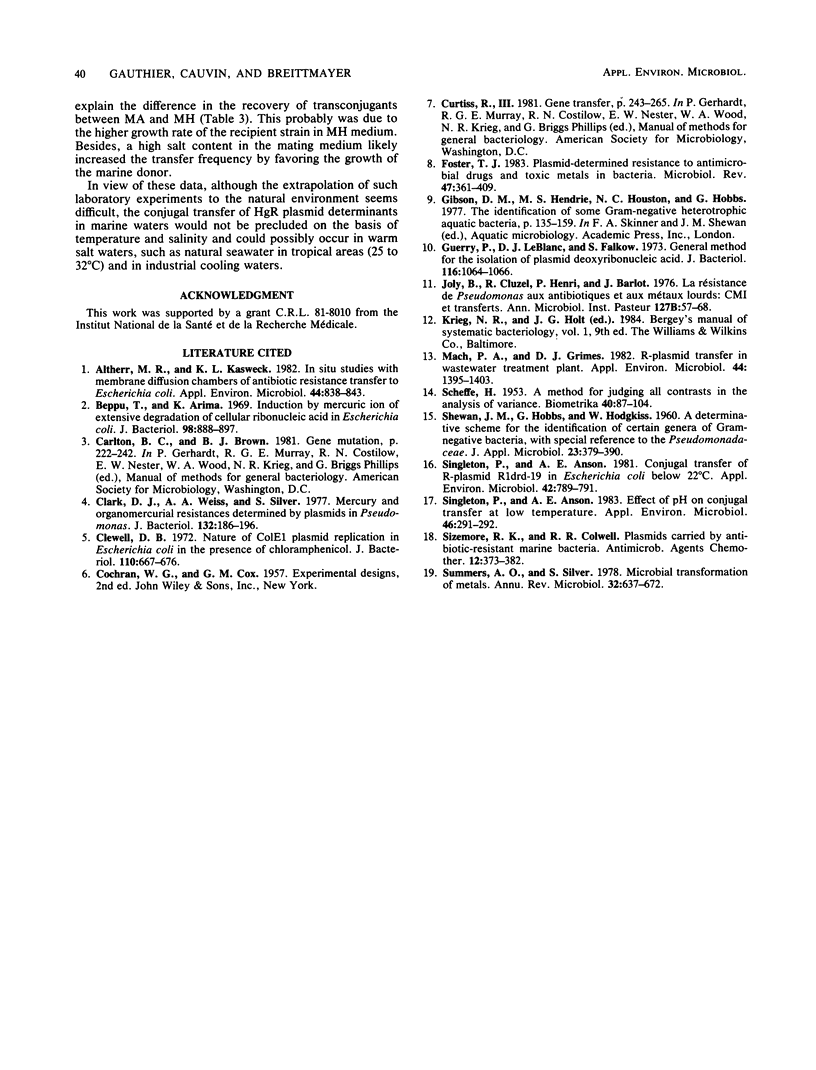Abstract
Thirty-one strains of marine bacteria were examined for their ability to transfer mercury resistance to Escherichia coli in complex media; eight strains were able to transfer their resistance marker, with frequencies ranging from 10(-3) to 10(-8). Frequencies generally increased with the increase of the mating period. Additional mating experiments were carried out with one strain, belonging to the pseudomonads, to estimate the influence of temperature, salinity, and time on the conjugal transfer frequency of mercury resistance markers. The higher frequencies occurred at 30 degrees C, in a salt medium (37%), after 24 h of mating.
Full text
PDF


Selected References
These references are in PubMed. This may not be the complete list of references from this article.
- Altherr M. R., Kasweck K. L. In situ studies with membrane diffusion chambers of antibiotic resistance transfer in Escherichia coli. Appl Environ Microbiol. 1982 Oct;44(4):838–843. doi: 10.1128/aem.44.4.838-843.1982. [DOI] [PMC free article] [PubMed] [Google Scholar]
- Beppu T., Arima K. Induction by mercuric ion of extensive degradation of cellular ribonucleic acid in Escherichia coli. J Bacteriol. 1969 Jun;98(3):888–897. doi: 10.1128/jb.98.3.888-897.1969. [DOI] [PMC free article] [PubMed] [Google Scholar]
- Clark D. L., Weiss A. A., Silver S. Mercury and organomercurial resistances determined by plasmids in Pseudomonas. J Bacteriol. 1977 Oct;132(1):186–196. doi: 10.1128/jb.132.1.186-196.1977. [DOI] [PMC free article] [PubMed] [Google Scholar]
- Clewell D. B. Nature of Col E 1 plasmid replication in Escherichia coli in the presence of the chloramphenicol. J Bacteriol. 1972 May;110(2):667–676. doi: 10.1128/jb.110.2.667-676.1972. [DOI] [PMC free article] [PubMed] [Google Scholar]
- Foster T. J. Plasmid-determined resistance to antimicrobial drugs and toxic metal ions in bacteria. Microbiol Rev. 1983 Sep;47(3):361–409. doi: 10.1128/mr.47.3.361-409.1983. [DOI] [PMC free article] [PubMed] [Google Scholar]
- Guerry P., LeBlanc D. J., Falkow S. General method for the isolation of plasmid deoxyribonucleic acid. J Bacteriol. 1973 Nov;116(2):1064–1066. doi: 10.1128/jb.116.2.1064-1066.1973. [DOI] [PMC free article] [PubMed] [Google Scholar]
- Joly B., Cluzel R., Henri P., Barjot J. La résistance de Pseudomonas aux antibiotiques et aux métaux lourds: CMI et transferts. Ann Microbiol (Paris) 1976 Jul;127(1):57–68. [PubMed] [Google Scholar]
- Mach P. A., Grimes D. J. R-plasmid transfer in a wastewater treatment plant. Appl Environ Microbiol. 1982 Dec;44(6):1395–1403. doi: 10.1128/aem.44.6.1395-1403.1982. [DOI] [PMC free article] [PubMed] [Google Scholar]
- Singleton P., Anson A. E. Conjugal transfer of R-plasmid R1drd-19 in Escherichia coli below 22 degrees C. Appl Environ Microbiol. 1981 Nov;42(5):789–791. doi: 10.1128/aem.42.5.789-791.1981. [DOI] [PMC free article] [PubMed] [Google Scholar]
- Singleton P., Anson A. E. Effect of pH on conjugal transfer at low temperatures. Appl Environ Microbiol. 1983 Jul;46(1):291–292. doi: 10.1128/aem.46.1.291-292.1983. [DOI] [PMC free article] [PubMed] [Google Scholar]
- Summers A. O., Silver S. Microbial transformations of metals. Annu Rev Microbiol. 1978;32:637–672. doi: 10.1146/annurev.mi.32.100178.003225. [DOI] [PubMed] [Google Scholar]


